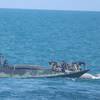British Columbian boat builders pioneered aluminum construction in the 1960s and '70s in the building of efficient commercial fishing boats. Aluminum won wide acceptance in BC for its low maintenance costs and durability. Since that time they have honed their skills in the craft of aluminum fabrication on a wide range of single and multi-hulled crew boats, yachts, ferries and pilot boats. Point Hope Shipyard in Victoria, earned recognition for their part in the fabrication of modules for the Incat designed fast ferry project where weight and strength were important criteria.
Now, utilizing workers who have come out of this tradition, Point Hope Shipyard in Victoria, BC are building to a highly evolved pilot boat design.
Scheduled for delivery to the Pacific Pilotage Authority in early 2003, the 22.5 m boat will be assigned to the north coast working in the 20-ft. tides and storm tossed waters between the port of Prince Rupert and the pilot's rendevous point off the Triangle Island light . The new boat is designed by the well known British designer of pilot boats and similar craft, Camarc Ltd. of Shoreham, England. Peter S. Hatfield Ltd. are acting as the owner's representatives, and were involved in the selection of Point Hope as the building yard. The yard's expertise and experience in high tech fabrication of light weight aluminum vessels was a definite asset in the selection process. Point Hope's Fabrication Manager Brent Johnstone has many years of experience to go with the half dozen certificates on his office wall. "We built with a combination of traditional and modular construction," he says with pride, "All of the stress areas on the boat have double continuous welds. We would rather do it properly the first time than to be doing warrantee work later."
Because the boat has an 8 x 0.75-in. inside keel, the two bottom strakes were first welded together on the shop floor, then fitted to a steel jig where the keel was added. Subsequently additional strakes were added as were modular sections of framing with stiffeners in place. The general skills that make a good welder are the same for a high speed boat such as this as those for a heavier displacement hull. "But," explains Johnson, "In steel welding, a welder's talent can overcome any little variations, however aluminum welding requires talent but it is also driven by parameters and procedures. Our welders have lots of talent, but they are also precise. They are all alumni of the fast ferry project and certified under the Canadian Welding Bureau."
Accounts of excellent boat builders who have gone bankrupt for lack of business acumen are legion. At Point Hope, owner and CEO Bill McKechnie brings years of successes in various businesses to the yard. After a long career he had taken semi-retirement to buy a classic yacht and begin an echo tourism business, but the opportunity to own and manage Point Hope brought him back to the work-a-day business world. McKechnie and his crew are looking to enhance the yard's US and Canadian repair work on their 800 ton marine railway and 200 ton floating drydock. But he is also excited about the opportunities to take the yard beyond its profitable repair and occasional new build status to a greater emphasis on the unique facilities and skill set available. "The yard benefited from the Fast Ferry experience and is now consolidating its position with this pilot boat," he explains, "Our big climate controlled building shed is a huge asset.
Now we would like to build boats of this class for customers around the world. We would also be interested in building one of these Camarc-class boats as a 30-knot luxury yacht." The idea hangs tantalisingly in the air. A visit to the huge building shed shows the pilot boat, with its sleek sheer line and 18 degree dead-rise at the transom. Its pair of 933 kw (1,250 hp) main engine nearly ready to pump water tons of water through the big 650 m/m jets, all speak to speed. While the long and tapered 6.5-metre wide hull promises a sea kindly ride even at speed. The wheel house, currently being finished to the pilot's requirements, as determined by a wooden mock up that they came to the yard to test, is carried aft to an accommodation area for up to eight pilot-passengers. This area and additional accommodation in the hull, tempt the imagination to the thought of a robust high-speed yacht with proven sea keeping characteristics. At a total cost of a little over $2.6 million Canadian ($1.7 million) in this current version, it is not beyond the realm of possibility that this could make an attractive basis for such a project.
Featured videos

Inmarsat Enhances Service to Drive Digitalization

Tracking Foreign Vessels Working in the U.S. Jones Act Market

Inside the Electrified Truckable Tug
Subscribe for
Maritime Reporter E-News
Maritime Reporter E-News is the maritime industry's largest circulation and most authoritative ENews Service, delivered to your Email five times per week









